
~~~~~~~~~~~~~~~~~~~~~~~~~~~~~~~~~~~~~~~~~~~
Live Earth Farm (Com)Post
7th Harvest Week, Season 12
May 14th - 20th, 2007
~~~~~~~~~~~~~~~~~~~~~~~~~~~~~~~~~~~~~~~~~~~
(click here for a pdf of the paper
version of this newsletter)
In this issue
--Greetings from Farmer Tom
--News from the Field
--"Strawberry Bounty" next week!
--Mini-Camp
--Outstanding in the Field Dinner update
--Pictures around the farm
--What's in the box this week
--Notes from Debbie's Kitchen
--Calendar
"...mankind and the planet are still best served
by the social model constructed from the fabric of small independent
farms, businesses, and communities interwoven into a social blanket of
magnificent diversity and great natural strength."
~ Lynn Miller
Greetings from Farmer Tom
~~~~~~~~~~~~~~~~~~~~~~~~~~~~~~~~~~~~~~~~~~~~~~~~
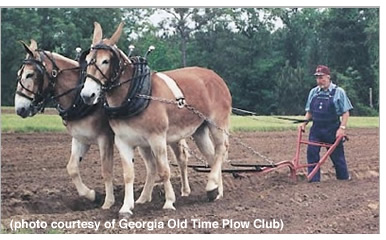 It is Spring of 2015 and I am preparing a 2-acre piece of land that has been
resting for three years. The land has been in pasture, grazing chickens, cows,
pigs, and then planted to a cereal grain. With its fertility restored, the soil
is now ready to be cultivated for growing annual vegetables again. I am slicing
through the rich, dark, musky-smelling soil, and a flock of robins follows close
behind feasting on earthworms and insects as the walking plow pulled by a team
of mules gently turns the soil. I enjoy the view of my rapeseed crop, which is
in full bloom. I grow rapeseed for oil in order to belong to the local veggie-oil
cooperative, which now presses enough to meet the demand of each member to run
their farm machinery.
It is Spring of 2015 and I am preparing a 2-acre piece of land that has been
resting for three years. The land has been in pasture, grazing chickens, cows,
pigs, and then planted to a cereal grain. With its fertility restored, the soil
is now ready to be cultivated for growing annual vegetables again. I am slicing
through the rich, dark, musky-smelling soil, and a flock of robins follows close
behind feasting on earthworms and insects as the walking plow pulled by a team
of mules gently turns the soil. I enjoy the view of my rapeseed crop, which is
in full bloom. I grow rapeseed for oil in order to belong to the local veggie-oil
cooperative, which now presses enough to meet the demand of each member to run
their farm machinery.
Last year we couldn't afford to use our delivery truck because the price of biodiesel
was over $12 a gallon, and our allotment of rapeseed oil was only sufficient
to run the farm machinery.
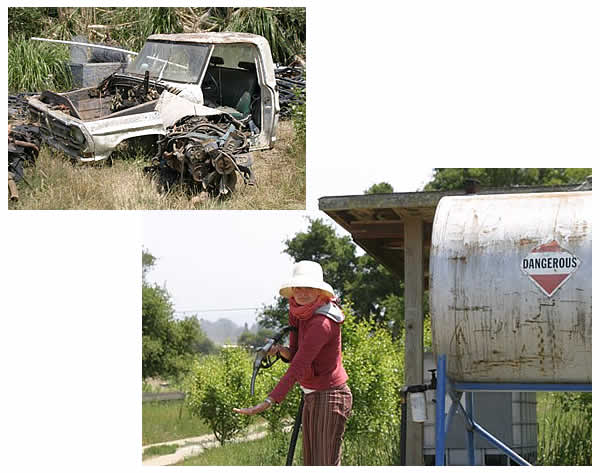 Thanks to an arrangement with our neighbor, we are
still able to haul our produce to Santa Cruz using his electric van, which we
were able to charge using our 100 kilowatt array of solar panels. This year I
am hoping to increase our production of rapeseed oil to have enough to transport
our produce with our converted diesel truck. In Santa Cruz, CSA members have
formed a small Food Distribution Co-op of electric-powered, lightweight trucks
to haul our produce over the hill.
Thanks to an arrangement with our neighbor, we are
still able to haul our produce to Santa Cruz using his electric van, which we
were able to charge using our 100 kilowatt array of solar panels. This year I
am hoping to increase our production of rapeseed oil to have enough to transport
our produce with our converted diesel truck. In Santa Cruz, CSA members have
formed a small Food Distribution Co-op of electric-powered, lightweight trucks
to haul our produce over the hill. 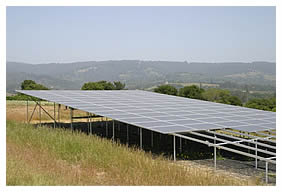 Each drop off location is a miniature food
center, where members receive a set share of food items, all grown within 50-100
miles. The food is supplied by a large network of over 200 small-scale organic
family farmers. It has really worked well for us to join this network, which
started as result of consumers and local farmers teaming up in order to provide
an adequate food supply to the Bay Area. More than 100,000 members form this
network. As the mules turn to do another pass down the field, I am amazed how
much things have changed in the last 8 years.
Each drop off location is a miniature food
center, where members receive a set share of food items, all grown within 50-100
miles. The food is supplied by a large network of over 200 small-scale organic
family farmers. It has really worked well for us to join this network, which
started as result of consumers and local farmers teaming up in order to provide
an adequate food supply to the Bay Area. More than 100,000 members form this
network. As the mules turn to do another pass down the field, I am amazed how
much things have changed in the last 8 years.
Debbie, our tireless CSA coordinator, and her husband Ken, who currently spearheads “World
Without Oil,” an on-line alternate reality game [www.worldwithoutoil.org],
got me thinking about how a shortage of fuel would affect the farm. At first
thought it is pretty frightening to imagine such a scenario; it is one of survival.
Instead of causing fear, however, the value of this exercise (of playing the
game, if you will – Ken’s tagline is “play it before you live
it!”),
is that it taps into what I consider our most important resource: our creative
adaptability. My fictional description of how farming in 2015 might look may
just be a nice dream right now, but it may reflect a new reality we need to embrace.
Although organic farming does not depend on fertilizers and pesticides derived
from oil, fossil fuels and its many derivatives still play a big role in the
current operation of our farm. I am not someone who shies away from a challenge,
especially one which ultimately aims to create a more sustainable farming environment,
however replacing fossil fuels is one challenge that affects the very foundation
our civilization is built upon. The energy we harness from fossil fuels has allowed
us to enjoy an immensely rich life; so much so, that we are now reaching the
limits of nature's tolerance and capacity. With signs of global warming, water
shortages, dwindling marine resources, and food and oil shortages, we are at
a point where we have to re-invent ourselves in order to live sanely and sustainably
on this planet we call Home.
Home for me is a place where I can enjoy the company of family and friends, and
it’s high time we "homo sapiens" become more humble and stop
acting like a bully trying to dominate nature. It is time to reconnect, listen
and learn from our planet-mates who have been here much longer and have done
everything we want to do without guzzling fossil fuels, polluting, and jeopardizing
our future. Re-learning from nature and doing it her way is both an exciting
and urgent moment in the short history of our species.
In farming, the dominant philosophy for the last 50 years has been to continuously
get bigger, to the point that now only 1% of the population is involved in growing
food. I believe this is our starting point. In order to turn things around we
need to not only increase the number of farmers and gardeners who grow food,
but to build new linkages which form diverse and cooperative relationships, mimicking
the interconnectedness we find in nature. With the price of fuels increasing
and fossil fuels becoming more scarce, I am hopeful that the conditions for such
a trend are ripe to take shape. I can imagine how, in the future, we will convert
millions of acres of farmland now dedicated to monoculture and corporate extractive
farming practices into a rich carpet of smaller-scale farms producing an abundant,
diverse, seasonal bounty of food. It would bring young people who want to start
farming back to the land. It would strengthen our communities, whose skills and
resources would in turn contribute to living sustainably in one place. I am optimistic
that the act of growing food can serve as a catalyst for us to read and learn
from nature's sacred book, and reconnect us with all the living creatures with
which we share this Home.
News from the Field
~~~~~~~~~~~~~~~~~~~~~~~~~~~~~~~~~~~~~~~~~~~~~~~~
Last week the USDA quarantined 8 Bay Area counties infested with the light brown
apple moth. Nurseries and farms located within a mile of a spot where the moth
has been found must have each shipment inspected and certified before it can
move. Nurseries and farms located farther from moth sites must undergo a one-time
visual inspection. The moth was introduced from Australia and supposedly loves
to munch on a large range of fruits, vegetables, and ornamental plants. I sure
hope we will not be affected by this. Imagine if every CSA share needed to be
inspected before we could deliver them to you... hmm, and I thought rising fuel
prices were challenging!!!
What's new and upcoming? The fennel looks great so we should see those in a week;
Radicchio, more mustard greens, and possibly the first Summer Squash are also
imminent. And the blackberries (Extra Fruit option only) are getting ripe! 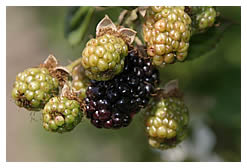
<back to top>
"Strawberry Bounty" next week!
~~~~~~~~~~~~~~~~~~~~~~~~~~~~~~~~~~~~~~~~~~~~~~~~
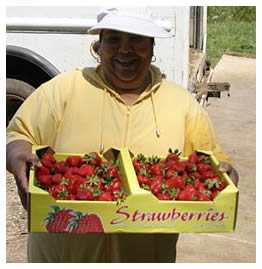 The strawberry production is really picking up now, so next week (not this
week - no jumping the gun!) members who had signed up for our “Strawberry
Bounty” option
will see a jump in the number of baskets of strawberries next to their name!
So as not to get too many phone calls along the lines of “how come I didn’t
hear about this?” let
me explain. This option was offered as an alternative to the 80 or so people
who were on the “Extra Fruit” waiting list, because there were no
more “Extra Fruit” shares left. It wasn't offered to the membership
at large (we simply wouldn't have had enough!) so that's why you didn't hear
about it. – Debbie
The strawberry production is really picking up now, so next week (not this
week - no jumping the gun!) members who had signed up for our “Strawberry
Bounty” option
will see a jump in the number of baskets of strawberries next to their name!
So as not to get too many phone calls along the lines of “how come I didn’t
hear about this?” let
me explain. This option was offered as an alternative to the 80 or so people
who were on the “Extra Fruit” waiting list, because there were no
more “Extra Fruit” shares left. It wasn't offered to the membership
at large (we simply wouldn't have had enough!) so that's why you didn't hear
about it. – Debbie
Angeles and a flat of fresh-picked berries
<back to top>
Mini-Camp
~~~~~~~~~~~~~~~~~~~~~~~~~~~~~~~~~~~~~~~~~~~~~~~~
This year’s Mini Camp starts Friday evening August 24th with a pot-luck
(pot-luck will start at around 7pm) and ends Sunday 26th before lunch. What is
Mini Camp? Since 1999, CSA members and their children have come to join us for
a weekend "camping" stay at the farm. This yearly event is designed
so participants can experience the farm's peacefulness without concern of having
to drive home at the end of the day.
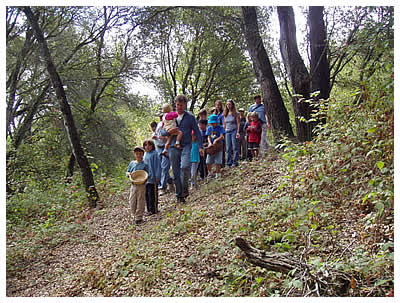 Equipped with baskets, we spend our days
harvesting, tasting and discovering the magnificent diversity of fruits, vegetables
and herbs growing on the farm, and then prepare a meal from the bounty we harvested.
Ambitious yet fun, it compels everyone to explore all corners of the land. It
is a time to enjoy being together, to meet other CSA members, and to allow the
children to set the pace. Farm games such as finding the 'weirdest' most interesting,
bizarre-looking fruit or vegetable are popular, and so is pizza-making (in our
wood-fired oven) with freshly harvested crops. Our hide-and-seek by moonlight
in the orchard has become a tradition among mini-campers! Visits to the farm
animals are also a must, to make sure that no living creature is left out of
the party! Families and kids of all ages are welcome!!
Equipped with baskets, we spend our days
harvesting, tasting and discovering the magnificent diversity of fruits, vegetables
and herbs growing on the farm, and then prepare a meal from the bounty we harvested.
Ambitious yet fun, it compels everyone to explore all corners of the land. It
is a time to enjoy being together, to meet other CSA members, and to allow the
children to set the pace. Farm games such as finding the 'weirdest' most interesting,
bizarre-looking fruit or vegetable are popular, and so is pizza-making (in our
wood-fired oven) with freshly harvested crops. Our hide-and-seek by moonlight
in the orchard has become a tradition among mini-campers! Visits to the farm
animals are also a must, to make sure that no living creature is left out of
the party! Families and kids of all ages are welcome!!
<> Cost is $50 per person (adults and children), to a maximum of $150 per
family, and you can pay during mini-camp.
<> You need to have been a CSA member for at least 2 months to participate,
and because space is limited, we only allow CSA members and their children, but
not extended family members.
Sign up now, as space in this popular event is limited to 12 families! Contact
Constance (farmer Tom's wife) at broz@baymoon.com or
call 831.760.0435 to register. Constance coordinates everything "mini-camp" and
she will give you the remaining specifics on what to bring/what to expect, etc.
<back to top>
Outstanding in the Field Dinner update
~~~~~~~~~~~~~~~~~~~~~~~~~~~~~~~~~~~~~~~~~~~~~~~~
Outstanding in the Field returns to Live Earth Farm Saturday June 9th to kick
off their 2007 season of farm dinners at the source.
Outstanding founder Jim Denevan – who was the chef at Gabriella Cafe in
Santa Cruz for 10 years before he left to devote himself to farm dinners and
his sand art – will prepare the meal with help from his crew. Chef Jim
will have a great diversity of LEF vegetables for his five-course menu, and the
season's first fruits, including blackberries and plums, will be juicy and ripe.
Once again we'll fire up “Toasty” the sculptured wood-fired earthen
oven for fresh baked bread. Live Earth Farm also has goats, which means fresh
goat cheese! Fresh eggs will come from Jim Dunlop and Rebecca Thistlethwaite
of nearby TLC Ranch.
Come join us at the Outstanding table, on our hilltop overlooking Live Earth
Farm and the amazingly fertile Pajaro Valley. To reserve seats, go to http://www.outstandinginthefield.com/events.html
Below are pictures from a prior OitF dinner at the farm. Chef Jim Denevan looks
out over the fields just above the farm as the sun descends; the row of tables
at the farm dinner (it really is literally out there in the field!);
OitF assistant Kat prepares bread dough for Toasty!
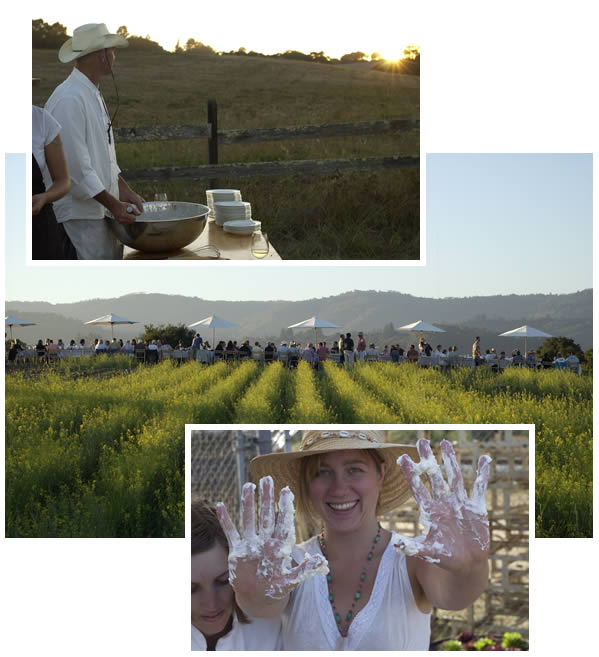
<back to top>
What's in the box this week
~~~~~~~~~~~~~~~~~~~~~~~~~~~~~~~~~~~~~~~~~~~~~~~~
(Content differences between Family and Small
Shares are underlined and italicized; items with a “+” in
Family Shares are more in quantity than in Small; anticipated quantities are
in parentheses. Sometimes the content of your share will differ from what's on
this list, but we do our best to give you an accurate projection. It's Mother
Nature that throws us the occasional curve ball!)
Family Share:
Red Ace beets
Broccoli (LEF) or cauliflower (Lakeside)
Chantenay carrots
Chard or kale
Japanese cucumbers (2) (Nagamine Nursery)
Garlic +
Lettuce (2-3)
Onions +
Fava beans +
Asian greens (Tatsoi or Mizuna)
Radishes
Spinach (bagged)
Strawberries (1 or 2 bskts)
Small Share:
Broccoli (LEF) or cauliflower (Lakeside)
Chantenay carrots
Chard or kale
Japanese cucumbers (1) (Nagamine Nursery)
Garlic
Lettuce (1)
Onions
Fava beans
Asian greens (Tatsoi or Mizuna)
Radishes
Strawberries (1 bskt)
Extra Fruit Option:
3 to 4 more baskets of strawberries!
Notes from Debbie's Kitchen
~~~~~~~~~~~~~~~~~~~~~~~~~~~~~~~~~~~~~~~~~~~~~~~~
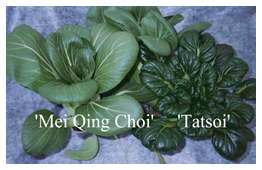 Tatsoi
Tatsoi
Tom says you’ll either be getting mizuna or tatsoi, so since I talked about
the mizuna last week, thought I’d fill you in on tatsoi this week! Tatsoi
is another Asian green, like mei quing choi and mizuna. Tatsoi and mizuna, when
small, are great in salad mixes. Tatsoi have round, slightly wrinkly dark green
leaves on a white stem. It grows in a bunch connected at the root much like spinach
(Tom didn't take a picture of tatsoi for me, so I went online and found this
nice shot on the University of Kentucky website which compares tatsoi and mei
quing choi side by side. Thank you, U of K – nice photo!) Since the leaves are
many different sizes and the bunches are smallish, Tom says they will be cut
off at stem level and bagged.
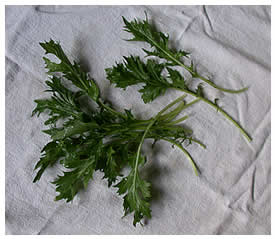 Try
using tatsoi as you might other greens like chard or spinach. The smaller leaves
can be used raw in your salads. Bigger leaves and stems can be steamed or sautéed
any number of ways.
Try
using tatsoi as you might other greens like chard or spinach. The smaller leaves
can be used raw in your salads. Bigger leaves and stems can be steamed or sautéed
any number of ways.
At right is a photo of the mizuna too, since some of us may be
getting this again this week, and I didn't have a photo last week!
Meanwhile, here’s
a tatsoi recipe I found online from a CSA-style farm back east:
Tatsoi in Mustard Dressing
from Covered Bridge Produce in Pennsylvania
The mustard dressing compliments the tangy taste of the tatsoi, while the dark
leaves and white stalks contrast each other.
12 oz. washed and chopped tatsoi
2 medium scallions
2 tbsp. lemon juice
1 tbsp. Dijon mustard
1/4 tsp. salt
3 tbsp. olive oil
In a small bowl whisk together lemon juice, mustard, salt and oil. In a wide
skillet or wok combine tatsoi and dressing and saute until leaves are tender
but stalks are still crunchy. Add scallion greens and toss. Arrange tatsoi on
serving platter and drizzle with any remaining dressing from the pan.
Cream of Radish Green Soup
Submitted by member Mickey McGushin, modified slightly
(makes 4-5 servings). Since the recipe calls for 2 bunches of radishes and we
usually only get one in our share in any particular week,
just halve the quantities and make a smaller batch (I’ve left the original
recipe quantities intact). - Debbie
2 bu. radishes
2 tbsp. unsalted butter
1 lg. leek, white part only, sliced and well washed [we don’t have leeks,
so I’d substitute some fresh onion]
4 C vegetable broth or water
1/2 lb. potatoes (about 1½ C), peeled and roughly diced
Salt and freshly ground white pepper
1/2 C creme fraiche or sour cream (optional)
Remove the radish tops. Pick through the radish leaves and discard any yellow
or otherwise discolored ones. Trim off and discard stems. Slice the radishes.
Place the butter, radishes and leek [or onion] in a soup pot over medium heat
and cook until the vegetables are soft, but not browned (about 7 minutes). Add
the broth, potatoes, and salt and pepper as desired, cover, increase the heat
to high, and bring to a boil. Reduce heat to an easy simmer and cook until potatoes
are nearly done. Remove lid and add the radish greens, continue to simmer, uncovered,
until potatoes and greens are tender. Transfer soup to a blender and puree until
smooth. Return soup to pot and gently reheat. Garnish soup servings with a dollop
of creme fraiche or sour cream if desired.
Fava idea
Prep favas now for later use: shell them and then boil 2 minutes, per usual.
Drain. When cool enough to handle, have a jar handy; squirt the favas directly
from their peel into the jar. Mix in a little olive oil and sea salt, close lid,
and refrigerate. Break ‘em out later for a quick snack, or add them to
any dishes or salads as you would normally!
Russian Beet Salad
from Nourishing Traditions, by Sally Fallon
6 medium beets
3 tbsp. raw apple cider vinegar
4 tbsp. extra virgin olive oil
1 tbsp. orange juice
pinch of sea salt
pinch of cayenne pepper
1 tsp. caraway seeds
pinch of cloves
pinch of cinnamon
1/2 tsp. finely grated lemon peel
1/2 tsp. finely grated orange peel
lettuce leaves, for garnish
Bake beets at 350 degrees about 1 hour or until tender. Peel and chop finely.
Mix remaining ingredients in a bowl, toss with beets and refrigerate several
hours. Serve on lettuce leaves.
Jiten's standard meat curry using fresh ingredients
from member Alicia Woodrow, who says, “as
new members, your veggies exceed expectations. My husband Jitendra (Jiten for
short) is from Maharashtra,
India. We used the fresh garlic and fresh onions in a standard
curry recipe where we usually use the mature versions. This was sooooo good.
It was spectacular. This was not a restaurant curry where they cook the bejeepers
out of the veggies in a quart of oil and throw in a handful of garam masala.
This is more of a home-style recipe where you can taste the ingredients. Here
is that recipe, with quantities adjusted for fresh garlic and onions from the
farm.”
Ingredients:
whole spices and oil
¼ C oil
2 sticks cinnamon
8 whole cloves
6 cardamom pods (black cardamom is very good, but regular pale cardamom is good
too)
wet ingredients
1 C of LEF fresh garlic, chopped. Use white and green, or all green.
Don't use the top part of the leaf that has sand under it (Or 3 tbsp. chopped
up regular dry/cured garlic) [note from Debbie: the green garlic is getting pretty
mature now; the cloves are fairly fully formed. The garlic is still less strong-flavored
than regular dry-cured garlic, so you could easily use one to two heads worth
of peeled cloves in this recipe, I think]
3 C fresh onions, chopped
3 - 4 tbsp. ginger, finely chopped
powdered spices
1 tbsp. turmeric
1 ½ tsp. powdered chilies
final ingredients
28 oz. can of (organic) tomatoes
2 ½ lbs. meat, cut up for curry
3 C water
Directions:
1. Fry the whole spices gently in the oil until they puff up slightly.
2. Add the onions, garlic, and ginger. Fry gently until they are very soft, approximately
20 to 30 minutes. Add small amounts of water as needed to prevent burning.
3. Add the powdered spices and fry for two minutes more.
4. Increase heat to high, and add the tomatoes. Cook until the tomatoes are hot.
5. Add the meat, get it hot also, then fry it for 6 minutes.
6. Boil the 3 C of water separately, then add it to the curry. Simmer everything
very gently until the meat is cooked.
Notes:
A. This can be made with no meat. Just pour over hard-boiled egg halves for egg
curry.
B. Good choices for meat are organic chicken thighs, whole organic chicken, skinned
and "cut for curry,” lamb pieces without fat, beef pieces. [note from
Debbie: even better than 'organic' try to get your meat from pasture-raised animals.
Read "The Omnivore's Dilemma" by Michael Pollan and you'll know why I say this.]
C. If desired, if using the lamb or beef, after frying the spices you can brown
the meat in the oil. Set the meat aside until time to add to the curry in step
5 and cook as directed.
D. Serve with rice or naan or bread.
<back to top>
Calendar of Events
~~~~~~~~~~~~~~~~~~~~~~~~~~~~~~~~~~~~~~~~~~~~~~~~
(see calendar on website for more info)
<> Fri. May 18, Four Fridays Mataganza Garden Internship (5/18, 5/25, 6/1,
6/8)
<>
Sat. Jun 9 Outstanding in the Field Dinner
<> Sat. Jun 23 Summer Solstice
Celebration
<> July 10-14 Teen Adventure Camp
<> Aug 24-26 Childrens Mini-Camp
<>
Sat. Oct 20 Fall Harvest Celebration
<back to top>
Contact Information
~~~~~~~~~~~~~~~~~~~~~~~~~~~
email the farm: farmers@cruzio.com
email Debbie with newsletter input or recipes: deb@writerguy.com
phone: 831.763.2448
web: http://www.liveearthfarm.net
~~~~~~~~~~~~~~~~~~~~~~~~~~~